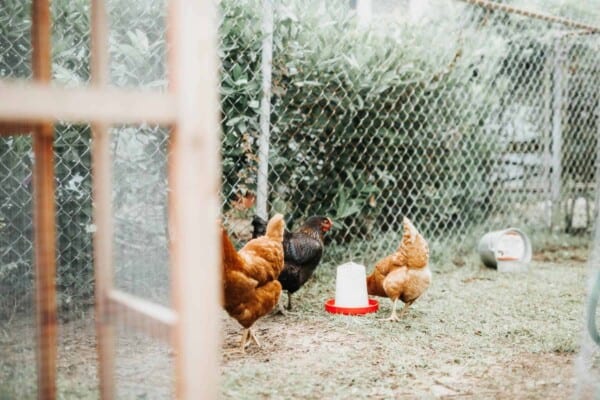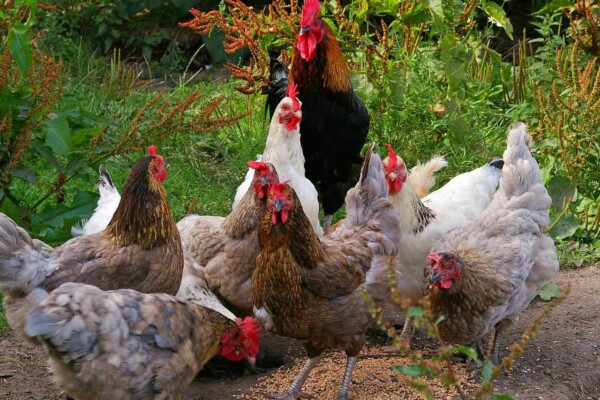If you are looking to live a healthier and greener life then there’s no better way to start than by buying yourself a bunch of chicken and raising them for their eggs and their meat. The trade off is simple, you give them a nice and comfortable life while they give you eggs.
As time moves on, they get older or they end up getting sick so you take them out and store their meat for quite some time after the butchering. Do this with ten chicken and you basically have yourself one of the easiest methods to change your life around for the better.
While there are definitely a lot of steps that we skipped over in between all of that, that’s fine for now mainly because that’s not what we’re here to talk about. We are not here to discuss the intricacies of raising the chicken from its peep constitution to its adult body.

Instead, what we’re here to discuss is a lot more fun than raising the chicken, we are about to delve into an informative guide that is meant to help you design your very own chicken coop.
There are ten steps in total that you need to follow, and if you do so properly you should be settled right up to own your very own chicken farm.
With that being said, let’s start off with the first step that you need to take, and quite possibly one of the most important ones too:
Think It Through

Do you really want to start a coop? Remember, there’s no turning back after this part, this is one of those steps that you really need to take your time in thinking through because you can’t change your mind afterwards.
After this step is up and done you need to realize the fact that if you fail to do anything you might end up taking the poor chicks down and trust us, you don’t want to do that. It’s easy to get attached to the little buggers, so neglecting them by accident can really affect you mentally.

So, ask yourself these questions: Do I have the budget for it? Do I have the space to build my dream coop in? Can I cover all of the costs that will come from the daily maintenance? Do I have the time to take care of them? What about ventilation? Food? Water?
If you couldn’t answer one of those questions, we urge you to sit down and think it through again. If you’re still drawing a blank then building a coop might not be the best choice for you. Don’t take this personally either, but you are juggling with the lives of the chicken, it’s just not right to mess with them like that.
Check Out Premade Plans

There is no shame in looking over other projects and getting inspired by what they did to make it work. Not all of us were born on a farm with a pitchfork in our hand so it’s no wonder that most people nowadays don’t know where to start as far as starting up a coop goes.
You can find plenty of premade plans all over the internet, look over recent projects and you’ll find yourself a plethora of ideas, tips and tricks and detailed steps to follow in order to get the desired result.
You may even get new ideas from this part of the process, ideas you never even considered to begin with. That’s the great thing about having access to internet, you can always check out someone else’s work to make sure you don’t make the same mistakes others have made before you.
Write it Down

Once you’re done settling on your dream coop you need to make sure that it’s all doable. In order to do this, you’ll need to write them down, all of those ideas you had that day, write them down and make sure that they work off of each other well.
The last thing you’d want is to find that you didn’t budget something right. During this part we also recommend making sketches of your dream coop. This will allow you to get a better grasp over the image you have in your head.
Believe it or not but for the most part, you don’t realize just how nonsensical some ideas can be until you give them form. Once you see them written or drawn down it should be pretty easy to proofread them and see whether they’re feasible or not.
Also, during this part, we recommend writing down a list of all of the materials and equipment that you’ll need to get the job done. This can be quite tedious but we urge you to not rush through this part. It is an essential part that you’ll need to have figured out before you can proceed, so don’t shoot yourself in the foot before you even made the first step in the right direction.
Choose a Coop Size

This may seem quite funny, but most people that start up their own coop don’t realize just how large their coop needs to be, so they end up having to sell some of the chicks back because they can’t all fit inside.
This has happened more than a handful of times, and it is all because people skipped over this vital step. If you don’t want to be a part of that very special group of people then we highly recommend you really think about how large you want the coop to be beforehand.
Consider how large the chicken will get and base that on how many chickens you’ve bought. Undoubtedly, some will pass away before they reach adulthood, but it’s better to have way too much room in the coop than to be cramped inside to the point where they can’t even move without knocking into each other.
Make sure that your chicken gets a minimum of up to 3 square feet per bird and around 4 square feet per outdoor run. They need freedom to run around in a lot, so make sure you give it to them accordingly.
Invest in a Good Roosting Pole

For every chicken coop you should have at least one rooster around for obvious reasons. The great thing about it is that a single healthy rooster can easily be enough for the whole coop. The only problem here is that the rooster will also need his very own roosting pole so make sure you have enough money for that.
What is a roosting pole? You know how roosters always wake up first thing in the morning and they start roosting away, essentially screaming their feathers off as they try their hardest to establish dominance? Yes, that’s what we’re talking about here.
Roosters need a certain space where they can freely roost in, and a roosting pole is the perfect choice that you can’t go wrong with.
A roosting pole should be at least two to three feet off of the ground, if it’s anywhere lower than that then you most likely will see the rooster avoid it and instead roost off of the roof of the coop.
Avoid this by giving them a nice and high roosting pole of up to four feet high. Make sure that they have around six to ten inches to move around in until they find the perfect position to sit in.
Invest in Sturdy Materials

This is an absolute necessity that you need to invest in because if you try to cheapskate your way out of it you might end up with a predator in your coop, chowing away at your little buddies.
Raccoons for example are notorious for breaking into coops and eating the poor flightless birdies up in a matter of minutes. We recommend investing in electric net fencing to really give the little intruder a wake-up call and teach him too never come back again.
At the same time however, there’s no real reason to invest in some sort of zombie apocalypse shelter materials either, you can just go for some sturdy and menacing looking fences and you should be fine.
Upcycle and Recycle Materials

The great thing about constructing a coop is that you can actually do it entirely by upcycling and recycling materials instead of buying them full price off the market.
The idea of using recycled materials may deter a lot of people, especially those that assume that this contradicts the step above which states that you should always go for high quality materials only, but remember, just because something is recycled that doesn’t mean it’s bad.
We recommend either trying this out with someone that knows what they’re doing or better yet, hire someone to show you how to do it to begin with. These knowledgeable people are usually everywhere, and they are pretty dirt cheap to hire too as they literally only have to show you the ins and outs once and afterwards you should be able to do it yourself in no time.
If you have no one to help you though, you might want to drop this idea altogether and just stick to store bought materials instead. Just remember, it’s always an option, although not always a good one at that.
Build the Coziest of Boxes

Remember, you’re not building a box for a chicken, multiple chicken will sleep in the same box so you need to make it at least four to five hens in size. If you make your boxes as large as the typical chicken then be ready to see them trample onto one another because that’s what they do.
Also, while we’re on this subject you should always place your boxes a couple of feet off the ground because chicken always love to be up in the air. We don’t know the exact reasoning behind it, all that we know is that they do, and if you place their boxes on the ground, they will pretty much never sit in them to begin with.
Also, it’s easier to get to the eggs if it’s higher up since you won’t need to bend over at all, they’ll be closer to your hands so that will be a good addition to your coop that will make your life easier.
Choose Between a Moveable and a Stationary Coop

As you can already tell from that subtitle alone, there are two options you can choose from. What’s the difference between the two? It’s pretty simple really:
- A moveable coop or a chicken tractor is a lot smaller and more mobile as the name suggests. The reason for this is because you’re meant to be able to restation it from place to place without causing too much trouble for the chicken. This is also a great option if you don’t have an actual pasture of your own available so you rent out different places every now and then for your chicken.
- A stationary coop is exactly what it sounds like, it’s the traditional coop style which is a lot heavier and sturdier. It is meant to be built in the middle of a pasture where your chicken can get most of their nutrition from, outside of everything you give them of course. This is also a lot more expensive of an option than a moveable coop, and yes, a lot larger too. This is meant for larger flocks, so if you have like 10 chickens then don’t go for a stationary coop.
Use the Deep Litter Method

The deep litter method implies that you repeatedly turn over the soiled bedding until you have enough droppings collected to use as compost. This waste will continue to decompose on the floor of the coop during all winter which should in turn help keep the chicken warm too.
As mentioned previously, you can then collect the droppings and use them to fertilize the ground. You can use the compost for vegetables or you can just place it on the pasture to get more out of it the next year, you decide.
Alternatively, you can build a man-sized door and enter the coop yourself every now and then to clean up the muck. You can have someone else do it for you, although it’s not worth it to pay someone else when the job itself is so simple that it can be done in less than an hour a couple of times per year.
If you really want to have a coop yourself then you might need to get down and dirty every now and then, and this is definitely one of those moments.
What to Consider Before You Build a Coop

Remember that first step we mentioned above? Well, here’s a direct list of everything you should pay attention to while designing your coop:
- The size of the coop – always remember, 3 to 4 square feet per chicken
- The elevation of the coop – they only use the place if they’re at a certain height, so always consider putting them around 8 to 12 inches off the ground
- The flooring of the coop – Dirt is cheap and risky, vinyl is safe and sleek, cement is the best but also very expensive, choose whichever option suits you best
- The roost pole for the roost
- The nesting boxes for the chicken
- The ventilation during summer
- The latches to protect them from predators
- The location is all based on whether you’re going to go for a stationary or a mobile coop. We talked above all about which option is best for which type of person
Conclusion

With that being said, you should now know all there is to constructing your very own chicken coop. While it may seem a bit hard to do at first, we highly recommend doing it if you have the budget and the resources for it because it’s definitely worth it.
Living a self-sufficient and self-sustaining life is amazing especially when the market is as volatile as it is today. Chicken breast may cost 5 dollars today and 15 tomorrow, so wouldn’t it be so much better to just never have to worry about any of that again?
On top of that the produce you’ll be getting will also be miles above what the people in the supermarkets are offering. Do you honestly believe that the eggs and the meat that you get from the supermarkets are real eggs and meat? Think again.

It’s all a sham, they’re all full of God knows what and guess what, the only way to fully know what went into the making of that meat is to be the one taking care of it all along. This is why so many people have started to build their own coops.
It’s simply put the only way to make sure that you’re not consuming chemicals instead of natural lean meat. Thank you for reading and good luck with your new chicken coop!
Contents












